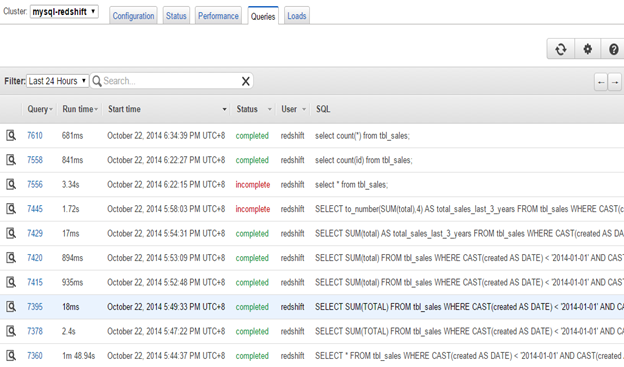

- REDSHIFT UNLOAD NOT EXPORTING ALL DATA HOW TO
- REDSHIFT UNLOAD NOT EXPORTING ALL DATA ZIP FILE
- REDSHIFT UNLOAD NOT EXPORTING ALL DATA DRIVERS
- REDSHIFT UNLOAD NOT EXPORTING ALL DATA DRIVER
- REDSHIFT UNLOAD NOT EXPORTING ALL DATA CODE
You to save data transformation and enrichment you have done in Amazon S3 into your Amazon S3 data Unload and consumes up to 6x less storage in Amazon S3, compared with text formats.

You can unload the result of an Amazon Redshift query to your Amazon S3 data lake in Apache Parquet, anĮfficient open columnar storage format for analytics. Ensure that the S3 IP ranges are added to your allow list. You can manage the size of files on Amazon S3, and by extension the number of files, by You can also specify server-side encryption with anĪWS Key Management Service key (SSE-KMS) or client-side encryption with a customer managed key.īy default, the format of the unloaded file is pipe-delimited ( | ) text.
REDSHIFT UNLOAD NOT EXPORTING ALL DATA HOW TO
REDSHIFT UNLOAD NOT EXPORTING ALL DATA DRIVER
REDSHIFT UNLOAD NOT EXPORTING ALL DATA DRIVERS
ODBC Drivers for REST API, JSON, XML, SOAP, OData. Using SSIS PowerPack you can perform Redshift data load or unload in few clicks. In order to test below package you first have to download SSIS PowerPackĭownload Demo SSIS Package – SSIS 2012/2014 ConclusionĪmazon Redshift is great way to start your data warehouse projects with very minimum investment in a very simple pay as you go model but loading or unloading data from redshift can be challenging task. To download above SSIS Package click on the below links. or source is DT_WSTR and target is DT_WSTR i.e. If needed convert Unicode/Non-unicode columns using Data Conversion Transform (This is not needed if source is DT_STR and target also DT_STR. Just map correct File columns to SQL Server fields and you should be good. Inside data flow you can use Flat File source and OLEDB Destination for SQL Server. Loop through files downloaded from Amazon S3 (Exported using Redshift UNLOAD Command) Step-5: Data Flow – Load Redshift Data Files to SQL Server
REDSHIFT UNLOAD NOT EXPORTING ALL DATA CODE
Here is sample C# code to un-compress GZip files You can skip this step if files are not compressed (not used GZIP option in command). Or you can write Script to un-compress those files (see below code).
REDSHIFT UNLOAD NOT EXPORTING ALL DATA ZIP FILE
If you have exported Redshift data as compressed files (using GZIP option) then you can use ZappySys Zip File task to un-compress multiple files. Once files are exported to S3 bucket we can download then to local machine using Amazon S3 Storage Task Step-3: Un-compress downloaded files Step-2: Download data files from Amazon S3 Bucket to local machine Must be of the format: credentials ‘aws_iam_role=…’ or ‘aws_access_key_id=… aws_secret_access_key=…. If you specify invalid accesskey or secretkey –or– you have misspelled keywords related to credentials - or - you have spaces before or after accesskey or secret key then you may get following error.ĮRROR: XX000: Invalid credentials. UNLOAD command issue with accesskey and secret key Please send all future requests to this endpoint.,Status 301,Error PermanentRedirect Both regions must be same.ĮRROR: XX000: S3ServiceException:The bucket you are attempting to access must be addressed using the specified endpoint. If your S3 bucket is in different region than Redshift cluster then above command may fail with “ 301 permanent redirect error” in that case you have to change your S3 bucket region. Region can be changed in AWS console (See S3 bucket properties and change location to match region with Redshift cluster region. UNLOAD command issue with Region mismatch (S3 bucket vs Redshift Cluster) These placeholders are replaced at runtime with actual value stored in specified variable. Notice how we used variable placeholders in SQL Command. Very first step would be to unload redshift data as GZip file using ExecuteSQL Task for Amazon Redshiftīelow is SQL Command you can use to extract data from Redshift. You will need AccessKey and SecretKey to fetch files from S3 Make sure you have Access to S3 Bucket where files will be dumped from Redshift.Make sure you have correct connection settings to connect to Redshift cluster (Host name, Port, UserId, Password, DB name etc).Load some sample data to Redshift (Red more here: How to load data to Redshift).Setup your Redshift cluster (Follow these instructions to setup redshift cluster).Extract/Unload Redshift Data using SSIS and Load into SQL Server Requirements for Extract Redshift Data using SSISīefore you UNLOAD data from Redshift, you have to make sure few things.


 0 kommentar(er)
0 kommentar(er)
